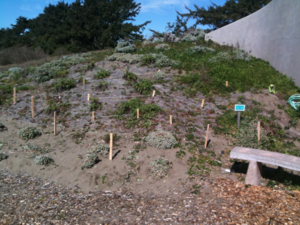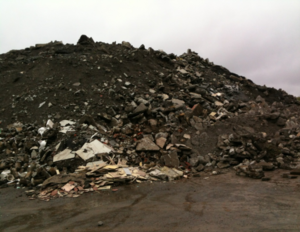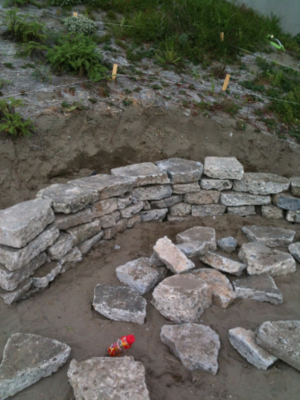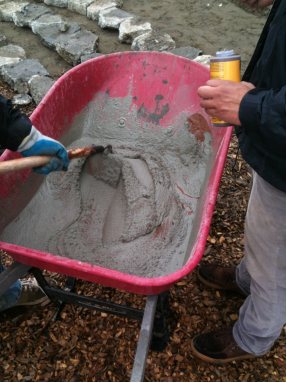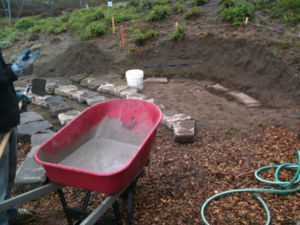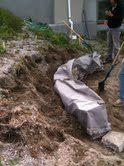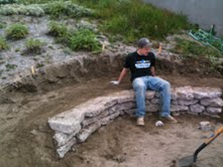Sophivorus (talk | contribs) m (Text replacement - "| affiliations = " to "| organizations = ") |
|||
| (53 intermediate revisions by 11 users not shown) | |||
| Line 1: | Line 1: | ||
[[File:sandycoveamphitheaterfinal.jpg | [[File:sandycoveamphitheaterfinal.jpg|thumb|The completed amphitheater]] | ||
== | |||
{{Project data | |||
| status = Verified | |||
| completed = 2012 | |||
| made = Yes | |||
| cost = 136 | |||
}} | |||
The goal of this project was to build a low-[[embedded energy]] amphitheater for [[Friends of the Dunes]] at the [https://web.archive.org/web/20160223061101/http://www.friendsofthedunes.org:80/HCNC/ Humboldt Coastal Nature Center]. The Sandy Cove Amphitheater consists of three arced retaining walls made from urbanite, or reused concrete, to form its structure. It will mainly be used as an environment to instruct and lecture young students about the dunes between Arcata Bay and the Pacific Ocean. It may also be utilized as a seating area for the general public. | |||
{{Video | |||
| video = GBVjZTJpVNQ | |||
}} | |||
== Introduction == | == Introduction == | ||
The Builders of the Bay are a part of Humboldt | |||
The Builders of the Bay are a part of Cal Poly Humboldt's spring 2012 Engineering 215 course. [[:Category:Engr205 Introduction to Design|Engineering 215 Intro to Design]] The Builders of the Bay consist of [[User:ccm331|Cory McGill]], [[User:TylerLowe|Tyler Lowe]], and [[User:jl2357|Jairo Luque Villanueva]]. The team worked with [http://www.friendsofthedunes.org/| Friends of the Dunes] on building an amphitheater for the Humboldt Coastal Nature Center. Friends of the Dunes is a non-profit organization working to conserve the natural diversity of coastal environments through community supported education and stewardship programs<ref name="Ref1">. | |||
Friends of The Dunes, 2012. <http://www.friendsofthedunes.org/> (Apr. 5, 2012)</ref>. The Sandy Cove Amphitheater will be used as a main center of teaching and learning at the Humboldt Coastal Nature Center. The Sandy Cove Amphitheater is constructed of stacked slabs of recycled concrete obtained from Kernen Construction. The Sandy Cove Amphitheater is a 137 degree section of a circle with three retaining walls increasing in height and length from the front to the back. | Friends of The Dunes, 2012. <http://www.friendsofthedunes.org/> (Apr. 5, 2012)</ref>. The Sandy Cove Amphitheater will be used as a main center of teaching and learning at the Humboldt Coastal Nature Center. The Sandy Cove Amphitheater is constructed of stacked slabs of recycled concrete obtained from Kernen Construction. The Sandy Cove Amphitheater is a 137 degree section of a circle with three retaining walls increasing in height and length from the front to the back. | ||
[[File: | [[File:Amphitheater on dune.png|thumb|center|The Sandy Cove Amphitheater design]] | ||
== Problem Statement and Criteria == | |||
The objective of the Builders of the Bay is to design and construct a low-[[embedded energy]] amphitheater for the [[Friends of the Dunes]] organization. | The objective of the Builders of the Bay is to design and construct a low-[[embedded energy]] amphitheater for the [[Friends of the Dunes]] organization. | ||
| Line 16: | Line 29: | ||
File:Floorplan.jpg|The schematic of the Sandy Cove Amphitheater | File:Floorplan.jpg|The schematic of the Sandy Cove Amphitheater | ||
File:Side view.jpg |The dimensions and height of each level of the Sandy Cove Amphitheater | File:Side view.jpg |The dimensions and height of each level of the Sandy Cove Amphitheater | ||
</gallery> | </gallery> | ||
{| class="wikitable | {| class="wikitable" | ||
! Criteria | ! Criteria | ||
! Description | ! Description | ||
! Weight | ! Weight | ||
|- | |- | ||
| Safety | | Safety | ||
| Children can safely occupy the amphitheater. | | Children can safely occupy the amphitheater. | ||
|align="right"| 10 | | align="right"| 10 | ||
|- | |- | ||
| Durability | | Durability | ||
| The lifespan of the amphitheater is at least five years with only minor repairs done to the structure. | | The lifespan of the amphitheater is at least five years with only minor repairs done to the structure. | ||
|align="right"|9 | | align="right"|9 | ||
|- | |- | ||
| Aesthetically Pleasing | | Aesthetically Pleasing | ||
| The amphitheater demonstrates professionally appealing attributes according to the clients standards. | | The amphitheater demonstrates professionally appealing attributes according to the clients standards. | ||
|align="right"|8 | | align="right"|8 | ||
|- | |- | ||
| Capacity | | Capacity | ||
| 30 or more people can easily be seated and properly instructed on the amphitheater. | | 30 or more people can easily be seated and properly instructed on the amphitheater. | ||
|align="right"|7 | | align="right"|7 | ||
|- | |- | ||
| Environmental Impact | | Environmental Impact | ||
| Over 80% of the materials used to construct the amphitheater are recycled materials. | | Over 80% of the materials used to construct the amphitheater are recycled materials. | ||
|align="right"|4 | | align="right"|4 | ||
|- | |- | ||
| Cost | | Cost | ||
| The total cost of the amphitheater does not exceed $325. | | The total cost of the amphitheater does not exceed $325. | ||
|align="right"|6 | | align="right"|6 | ||
|} | |} | ||
== The Sandy Cove Amphitheater Solution == | == The Sandy Cove Amphitheater Solution == | ||
The Sandy Cove Amphitheater begins with three retaining walls constructed of stacked urbanite. The blocks of urbanite composing the three retaining walls are stacked in an offset manner to create a more structurally sound structure. These walls are then backfilled with sand. The first retaining wall is 16 inches high and each level of the amphitheater increases by that measurement as you move up the amphitheater. Each retaining wall is 3 feet wide. Each wall follows the same angle of curvature, which is of 137 degrees from a single, central point that is 5 feet in front of the first wall. The first wall has an arc length of 12 feet, the second wall has an arc length of 19 feet, and the third wall has an arc length of 26 feet. The mortar used in the construction of the amphitheater is concrete. | |||
{{Step | |||
| number = 1 | |||
| text = Stake Schematics | |||
| image = staked_dune.png | |||
| caption = Area is staked to plan schematics at site of implementation. | |||
}} | |||
{{Step | |||
| number = 2 | |||
| text = Retrieve Urbanite from a Demolition Waste Facility | |||
| image = demolition_waste.png | |||
| caption = Urbanite is found at various demolition sites. | |||
}} | |||
| | |||
{{Step | |||
| number = 3 | |||
| text = Piece together wall by stacking retrieved Urbanite | |||
| image = place_first_tier.png | |||
| | | caption = Place first tier without mortar to be sure your wall ends us strong throughout and level on the top layer. | ||
}} | |||
{{Step | |||
| number = 4 | |||
| | | text = Mix Mortar and add brown concrete dye. Dye should be added in a ratio of one bottle per two 60 lb bags of mortar. | ||
| image = mix_mortar.png | |||
| caption = Dye is added to make mortar look like the sand that the amphitheater is built on. | |||
}} | |||
| | {{Step | ||
| number = 5 | |||
| text = Take apart wall and rebuild while applying mortar this time. | |||
| image = apply_mortar.png | |||
| caption = Mortar is now applied to the wall built. | |||
}} | |||
{{Step | |||
| number = 6 | |||
| text = Place landscaping fabric at the back of the wall and backfill sand once mortar has dried. | |||
| image = backfill_wall.png | |||
| caption = Back fill wall to the top of this wall with sand to create the wide walls of this amphitheater. | |||
}} | }} | ||
{{ | {{Step | ||
| number = 7 | |||
| text = The first wall is now completed | |||
| image = first_tier_complete.png | |||
| caption = Completed first wall. | |||
}} | |||
== Costs == | == Costs == | ||
The cost of The Sandy Cove Amphitheater was $136.53 for all the necessary materials. Friends of the dunes donated $100.00 to the total cost of the amphitheater project and therefore the cost of $36.22 was split between the three team members. | |||
{| class="wikitable | The cost of The Sandy Cove Amphitheater was $136.53 for all the necessary materials. [[Friends of the dunes]] donated $100.00 to the total cost of the amphitheater project and therefore the cost of $36.22 was split between the three team members. | ||
! Quantity | |||
{| class="wikitable" | |||
! Quantity | |||
! Material | |||
! Source | |||
! Cost | |||
! Total | |||
|- | |||
| 6 | |||
| 8" stakes | |||
| Ace Hardware | |||
| align="right"| $0.68 | |||
| align="right"| $4.08 | |||
|- | |- | ||
| | | 7 | ||
| 2' Stakes | |||
| Ace Hardware | |||
| align="right"| $0.92 | |||
| align="right"| $6.08 | |||
|align="right"| $0.92 | |||
|align="right"| $6.08 | |||
|- | |- | ||
| | | 13 | ||
| Urbanite | |||
| | | Kernen Construction | ||
| | | align="right"| $162.50 | ||
| align="right"| $0.00 | |||
|align="right"| $ | |||
|align="right"| $ | |||
|- | |- | ||
| 1 | |||
|align="right"| $ | | Ball of string | ||
|align="right"| $ | | Ace Hardware | ||
| align="right"| $1.50 | |||
| align="right"| $1.50 | |||
|- | |- | ||
|| | | 7 | ||
|align="right"| $ | | Concrete mortar | ||
|align="right"| $ | | Ace Hardware | ||
| align="right"| $6.99 | |||
| align="right"| $48.93 | |||
|- | |- | ||
|-class="sortbottom" | | 1 | ||
|colspan="4" align="right" | '''Total Cost''' | | Landscaping fabric | ||
|align="right"|$136.53 | | Ace Hardware | ||
| align="right"| $28.99 | |||
| align="right"| $28.99 | |||
|- | |||
| 1 | |||
| Chisel | |||
| Ace Hardware | |||
| align="right"| $10.99 | |||
| align="right"| $10.99 | |||
|- | |||
| 4 | |||
| Mortar dye | |||
| Ace Hardware | |||
| align="right"| $8.99 | |||
| align="right"| $35.96 | |||
|- | |||
|- class="sortbottom" | |||
| colspan="4" align="right" | '''Total Cost''' | |||
| align="right"|$136.53 | |||
|} | |} | ||
=== Maintenance Costs === | === Maintenance Costs === | ||
The amphitheater will require an occasional upkeep and additional materials as applicable. Monthly inspections of the amphitheater should be made to make sure that none of the urbanite has been removed each retaining wall. Extra urbanite is being kept on site to provide the client with the appropriate material to fix the damage. | The amphitheater will require an occasional upkeep and additional materials as applicable. Monthly inspections of the amphitheater should be made to make sure that none of the urbanite has been removed each retaining wall. Extra urbanite is being kept on site to provide the client with the appropriate material to fix the damage. | ||
== Labor == | == Labor == | ||
[[File:piechartsandycove.png| | The following image shows the work involved in this project. | ||
[[File:piechartsandycove.png|center|thumb|This chart shows the compilation of hours spent on each phase of the design process. The total amount of time spent on this project was 287 hours.]] | |||
== Testing Results == | == Testing Results == | ||
The Builders of the Bay built and tested two separate retaining walls before the final installation of the walls at the Humboldt Coastal Nature Center. The purpose of these tests was to practice the actual building of the walls and to make sure the material we were recovering from Kernen Construction would be suitable to use for stacking and building the walls. | The Builders of the Bay built and tested two separate retaining walls before the final installation of the walls at the Humboldt Coastal Nature Center. The purpose of these tests was to practice the actual building of the walls and to make sure the material we were recovering from Kernen Construction would be suitable to use for stacking and building the walls. | ||
[[File:mockretainingwall.png| | [[File:mockretainingwall.png|center|300px|thumb|A practice wall we built to be sure that the urbanite was usable.]] | ||
== Summary and Next Steps == | == Summary and Next Steps == | ||
A total of 287 hours were spent on the design and completion of The Sandy Cove Amphitheater project. The Sandy Cove Amphitheater fits all specifications given to The Builders of the Bay. The amphitheater is safe due to wide steps, adequate step height and using sand as | |||
A total of 287 hours were spent on the design and completion of The Sandy Cove Amphitheater project. The Sandy Cove Amphitheater fits all specifications given to The Builders of the Bay. The amphitheater is safe due to wide steps, adequate step height and using sand as backfill. These are safety measures to keep the amphitheater from being too steep and to provide a soft surface to fall on instead of using solid concrete for the entirety of the amphitheater. Because the amphitheater is made of concrete and uses concrete mortar, the amphitheater is durable and will last five or more years with only minor repairs. Urbanite is an aesthetically pleasing material due to the fact that it matches all other retaining walls surrounding the facility. The capacity also meets the standard of seating 30 people or more. Using urbanite as the primary material meets our criterion of lowering the environmental impact by using mostly recycled materials. Lastly, using urbanite helped keep our cost low and well under our initial budget. | |||
== Update October 2016 == | |||
The amphitheater is a hit and used all the time. It is used as a place to gather during many FOD activities including weekly during field trip visits from local schools. The amphitheater could use some minor maintenance to fix the side stairs so they stay in place. | |||
[[File:Kids in the FOD Amphitheater.jpg|thumb|center|Kids in Sandy Cove on a field trip]] | |||
== Update October 2017 == | |||
[[File:Sandy Cove 2017.jpeg|thumb|center|The Sandy Cove]] | |||
The amphitheater that is used by students that are on field trips. It is used weekly if the weather allows it. It is evident that it needs some maintenance. Weeds need to be picked and some sand must be added to the stairs. | |||
== References == | == References == | ||
<references/> | |||
[[Category: | <references /> | ||
{{Page data | |||
| organizations = Cal Poly Humboldt | |||
}} | |||
[[Category:Engr205 Introduction to Design]] | |||
[[Category:Friends of the Dunes]] | [[Category:Friends of the Dunes]] | ||
[[Category:Construction and materials videos]] | |||
Latest revision as of 12:32, 28 February 2024
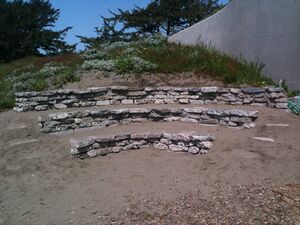
The goal of this project was to build a low-embedded energy amphitheater for Friends of the Dunes at the Humboldt Coastal Nature Center. The Sandy Cove Amphitheater consists of three arced retaining walls made from urbanite, or reused concrete, to form its structure. It will mainly be used as an environment to instruct and lecture young students about the dunes between Arcata Bay and the Pacific Ocean. It may also be utilized as a seating area for the general public.
Introduction[edit | edit source]
The Builders of the Bay are a part of Cal Poly Humboldt's spring 2012 Engineering 215 course. Engineering 215 Intro to Design The Builders of the Bay consist of Cory McGill, Tyler Lowe, and Jairo Luque Villanueva. The team worked with Friends of the Dunes on building an amphitheater for the Humboldt Coastal Nature Center. Friends of the Dunes is a non-profit organization working to conserve the natural diversity of coastal environments through community supported education and stewardship programs[1]. The Sandy Cove Amphitheater will be used as a main center of teaching and learning at the Humboldt Coastal Nature Center. The Sandy Cove Amphitheater is constructed of stacked slabs of recycled concrete obtained from Kernen Construction. The Sandy Cove Amphitheater is a 137 degree section of a circle with three retaining walls increasing in height and length from the front to the back.
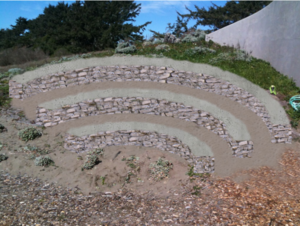
Problem Statement and Criteria[edit | edit source]
The objective of the Builders of the Bay is to design and construct a low-embedded energy amphitheater for the Friends of the Dunes organization.
-
The schematic of the Sandy Cove Amphitheater
-
The dimensions and height of each level of the Sandy Cove Amphitheater
| Criteria | Description | Weight |
|---|---|---|
| Safety | Children can safely occupy the amphitheater. | 10 |
| Durability | The lifespan of the amphitheater is at least five years with only minor repairs done to the structure. | 9 |
| Aesthetically Pleasing | The amphitheater demonstrates professionally appealing attributes according to the clients standards. | 8 |
| Capacity | 30 or more people can easily be seated and properly instructed on the amphitheater. | 7 |
| Environmental Impact | Over 80% of the materials used to construct the amphitheater are recycled materials. | 4 |
| Cost | The total cost of the amphitheater does not exceed $325. | 6 |
The Sandy Cove Amphitheater Solution[edit | edit source]
The Sandy Cove Amphitheater begins with three retaining walls constructed of stacked urbanite. The blocks of urbanite composing the three retaining walls are stacked in an offset manner to create a more structurally sound structure. These walls are then backfilled with sand. The first retaining wall is 16 inches high and each level of the amphitheater increases by that measurement as you move up the amphitheater. Each retaining wall is 3 feet wide. Each wall follows the same angle of curvature, which is of 137 degrees from a single, central point that is 5 feet in front of the first wall. The first wall has an arc length of 12 feet, the second wall has an arc length of 19 feet, and the third wall has an arc length of 26 feet. The mortar used in the construction of the amphitheater is concrete.
Costs[edit | edit source]
The cost of The Sandy Cove Amphitheater was $136.53 for all the necessary materials. Friends of the dunes donated $100.00 to the total cost of the amphitheater project and therefore the cost of $36.22 was split between the three team members.
| Quantity | Material | Source | Cost | Total |
|---|---|---|---|---|
| 6 | 8" stakes | Ace Hardware | $0.68 | $4.08 |
| 7 | 2' Stakes | Ace Hardware | $0.92 | $6.08 |
| 13 | Urbanite | Kernen Construction | $162.50 | $0.00 |
| 1 | Ball of string | Ace Hardware | $1.50 | $1.50 |
| 7 | Concrete mortar | Ace Hardware | $6.99 | $48.93 |
| 1 | Landscaping fabric | Ace Hardware | $28.99 | $28.99 |
| 1 | Chisel | Ace Hardware | $10.99 | $10.99 |
| 4 | Mortar dye | Ace Hardware | $8.99 | $35.96 |
| Total Cost | $136.53 | |||
Maintenance Costs[edit | edit source]
The amphitheater will require an occasional upkeep and additional materials as applicable. Monthly inspections of the amphitheater should be made to make sure that none of the urbanite has been removed each retaining wall. Extra urbanite is being kept on site to provide the client with the appropriate material to fix the damage.
Labor[edit | edit source]
The following image shows the work involved in this project.
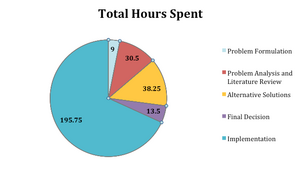
Testing Results[edit | edit source]
The Builders of the Bay built and tested two separate retaining walls before the final installation of the walls at the Humboldt Coastal Nature Center. The purpose of these tests was to practice the actual building of the walls and to make sure the material we were recovering from Kernen Construction would be suitable to use for stacking and building the walls.
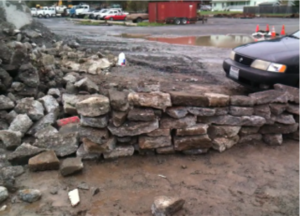
Summary and Next Steps[edit | edit source]
A total of 287 hours were spent on the design and completion of The Sandy Cove Amphitheater project. The Sandy Cove Amphitheater fits all specifications given to The Builders of the Bay. The amphitheater is safe due to wide steps, adequate step height and using sand as backfill. These are safety measures to keep the amphitheater from being too steep and to provide a soft surface to fall on instead of using solid concrete for the entirety of the amphitheater. Because the amphitheater is made of concrete and uses concrete mortar, the amphitheater is durable and will last five or more years with only minor repairs. Urbanite is an aesthetically pleasing material due to the fact that it matches all other retaining walls surrounding the facility. The capacity also meets the standard of seating 30 people or more. Using urbanite as the primary material meets our criterion of lowering the environmental impact by using mostly recycled materials. Lastly, using urbanite helped keep our cost low and well under our initial budget.
Update October 2016[edit | edit source]
The amphitheater is a hit and used all the time. It is used as a place to gather during many FOD activities including weekly during field trip visits from local schools. The amphitheater could use some minor maintenance to fix the side stairs so they stay in place.
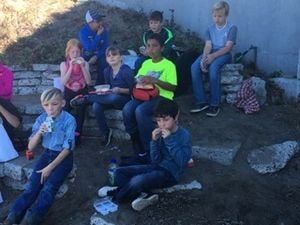
Update October 2017[edit | edit source]
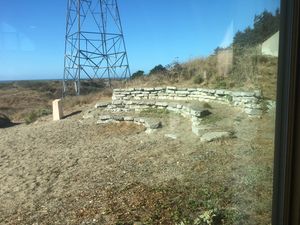
The amphitheater that is used by students that are on field trips. It is used weekly if the weather allows it. It is evident that it needs some maintenance. Weeds need to be picked and some sand must be added to the stairs.
References[edit | edit source]
- ↑ . Friends of The Dunes, 2012. <http://www.friendsofthedunes.org/> (Apr. 5, 2012)



